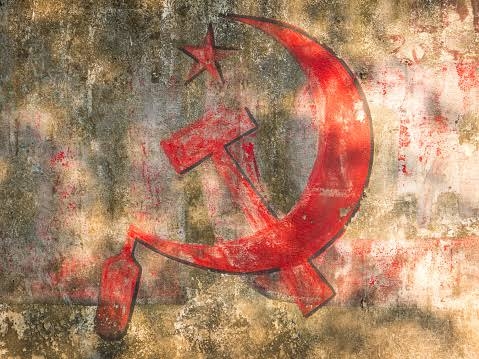Left, left-out: Fall of Left parties in India
Left has not only adrift all sense of direction and their previous holds also but also has become fitly insignificant. Insignificance – when a party you seek to ally with tells you to merge with them instead – decimate or dissolve yourself. This was the AAP’s response to sections of Left that wanted an alliance – ‘No alliance, but you can merge with us’.

The Left, which can always be found arousing contempt engaged in endless moralizing. The values witch red comrades lack the most. Unabatedly, not tired of acting as the self-appointed guardian and custodian of ‘democratic values' and ‘constitutional norms', all so- called. Specialized in terming democracy and democrats, as say, fascism and fascists – has been in decline,or always was.
Left has not only adrift all sense of direction and their previous holds also but also has become fitly insignificant. Insignificance – when a party you seek to ally with tells you to merge with them instead – decimate or dissolve yourself. This was the AAP’s response to sections of Left that wanted an alliance – ‘No alliance, but you can merge with us’.
And this snub came while the Left was going to town around early 2014, comparing AAP with Latin American social movements that forged radical- Left coalitions against the “Washington consensus”. Prakash Karat of the CPIM claimed AAP is doing precisely what the Left always wanted: “AAP’s agenda has long been the Communist programme.”
Of all the opposition parties left to wallow in their disappointment after the results of elections, either it is the 2019’s Lok Sabha Elections or the recent state elections, the front that can be seen loosing the most is Left. And it comes to no surprise either, that CPI(M) lost its national party status because of it’s marginalized presence nation wide. And this has resulted to such an extent that the communist parties have been reduced to a fraction of the seats they once held in Parliament, managing to win only 5 seats in Lok Sabha. They have fallen from winning 59 seats in 2004, to just 5 seats.
[The left side not even manage to win a single Lok Sabha seat in their former bastions of West Bengal and Tripura. They won just a single seat in Kerala and 4 in Tamil Nadu.]
The Left has drastically lost huge chunks of their vote-shares.
West Bengal: End of Red’s twirl
The Left had held the reins of government in West Bengal for an uninterrupted 34 years, from 1977 to 2011. However, even after Mamata Banerjee’s Trinamool Congress ousted the Left from power in the 2011 Assembly elections in Bengal, the Left led by the CPI(M) continued to be the primary Opposition, along with the Congress.
But the 2019 Lok Sabha polls has seen the sharpest decline in the Left’s voteshare in Bengal, with the CPI(M), CPI, RSP and Forward Bloc recording a combined voteshare of only 7.5%. Their Lok Sabha tally in the state – Zero.
On top of it, Mamata Banerjee's campaign against the Left had picked up steam during her protests in Singur and Nandigram, where the CPI(M) government had been accused of forcefully acquiring land from villagers for industrial projects, and was blamed for rampant human rights violations against locals who protested. The violence in Nandigram and the massive protests that followed swung a huge amount of support towards Mamata, leading to a decline in popularity for the Left that was large enough for it to lose the 2011 election.
And this political vacuum in the opposition space in Bengal began being filled up by the BJP. And the massive significance of BJP in the previous state Assembly elections, were no exception.
Tripura: Red Deceased
The two Lok Sabha seats in Tripura had been held by the Left from 1996 to 2019, with the CPI(M) winning both constituencies for six consecutive elections. The state government too was run by the Left for 25 straight years from 1993 to 2018.
In 2018, the BJP toppled Manish Sarkar’s Left Front government by winning 35 out of 59 Assembly seats. In the 2019 Lok Sabha polls, the BJP has won both seats in the state with a vote share of 49%. And now, in the state elections held this year, the BJP again turned the stakes and formed it’s government in Tripura, ‘Deceasing Red’.
Kerala: Left’s last hold
Kerala, where Chief Minister Pinarayi Vijayan leads the only Left Front state government in the country at present, is the last bastion of the communist parties in India. But there too, the Left alliance (LDF) has fallen from 8 Lok Sabha seats in 2014 to 1 seat in 2019.
The Congress-led UDF alliance has routed the Left in Kerala this time, winning 19 out of the 20 Lok Sabha seats.
Bihar conundrum: Roads of recurrence..?
Though the expected debar of leftism in India, became the quintessential in the previous elections of Punjab, West Bengal ,Tripura and other once upon a time bastions of left in India, the 2020’s election in Bihar showed the alarming inroads of Left there.
The liberation, an offshoot of the CPI(M-L) that spearheaded Naxal terrorism in Bengal and some other parts of the country in the late 1960s and early 1970s won 12 seats in the Bihar assembly elections lately.
This was the best ever performance of the party. Undoubtedly, the reason for the Liberation winning a record number of seats was not a sudden upsurge in popular support for it in Bihar, but the political plant that the Rashtriya Janata Dal-Congress led Mahagathbandhan provided to it.
(The Liberation was allotted 19 seats as part of the Mahagathbandhan of which it won 12.)
Political commentators say that such a high strike rate was possible because it could concentrate it’s resources and focus on 19 seats, unlike in the past when it contested anything-anywhere between 82(in 1990) and 109 (in 2005 seats.) Moreover the red party one just 3 seats in the 2015 assembly elections and none in 2010.
The alliance with ‘equals’
It can truly be considered by the above records that Liberations association with mainstream political parties like the Congress and the RJD allowed the Liberation to back the support of many who would have otherwise, been wary of the red radicals. Some analysts and observers call it simply a result of piggybacking on the RJD, meanwhile, the leftist media justify this strategic holding by praising leftism and arguing that left is an ideologically driven machine whose relentless work despite electoral failures is bound to reap dividends eventually.
‘Not a new force in Bihar’, Analysts argue that the performance of the Left in the Bihar elections has its roots in its long-lasting ideological presence in many pockets. Badri Narayan, director of the G.B. Pant Social Science Institute in Prayagraj, said the results are a very important moment for the Left, since they have turned back the clock to a time when the parties used to have around two dozen MLAs in the assembly of undivided Bihar. In fact, even until 1995, the Left parties had 25-35 MLAs in the Bihar assembly, with the CPI winning 20-25 seats in every election.
The reason for this vote base erosion, experts say, was the grip of ‘Mandal’ politics on the state.
“The Mandalisation of Bihar politics hit the Left. With the rise of a plebeian leader in Lalu Prasad Yadav, caste became the biggest fault line,” argued Ashwini Kumar, professor at the Tata Institute of Social Sciences. “But in Bihar, over the years, the Naxal movement became very rooted, becoming a quasi-Dalit movement.”
Dr Sanjay Paswan, BJP leader and an academic, concurred. “The Left were the central opposition in both the Centre and in Bihar until the 1960s. But with the emergence of anti-Congressism and socialism, they started becoming weak, and needed others to ally with.”
He added: ”When Lohia said that in India caste is class, it hit the Left parties directly. And the final blow to the Left was, of course, the emergence of Lalu Prasad Yadav, who made caste identities the centre of politics in Bihar. But such is the nature of politics that while Lalu’s Mandal politics was the reason for the Left’s decline, his own son has resurrected the Left.”
Senior journalist Nalin Verma, said a quick analysis of the seats where the Left, particularly Liberation (which has its roots in the Naxalbari movement of the 1960s), shows that these are all areas with a history of peasant and Naxal movements.
“If you see these areas, then you know they have always had a presence of the Left, because there has been a history of class struggle here. Politically, their presence may have gotten eclipsed by Mandal-Mandir politics, but ideologically, their presence has remained,” Verma said.
These strategic stunts are what that re-raved the way of Left in Bihar – scoring 16 out of 29 seats in Bihar, with the Liberation winning 12 of 19.
While at the macro level, factors such as India’s gradual movement towards the right of centre on economic issues and growing distance from the Left’s worldview could be cited as hindering the Left’s revival, it is actually poor local organisation on the ground and a failure to provide a strong opposition in states it once ruled, that is causing the Left’s rapid decline. And making a revival seem ever more improbable.
Even as it dies this Left gets no sympathy, but in fact arouses revulsion and contempt among many. Contempt-not from the dominant Hindutva forces, whom the Left considers its “arch enemy”, but from those regarded oppressed and marginalized-large sections of Dalit leaders and parties. The rise of Majlis-e-Ittehadul Musilmeen (MIM) shows that “minorities” also likely have a similar attitude towards the “Left and secular forces”.

contemplating society and politics through cultures.)

